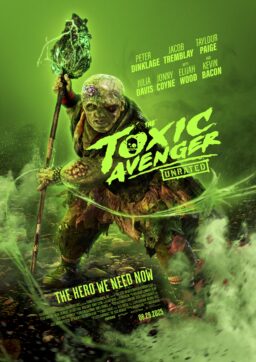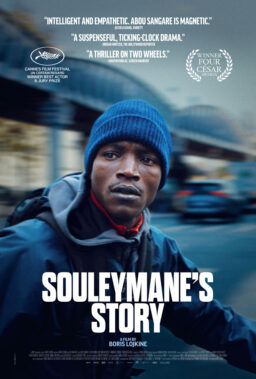It was a scary year. From corporate multiplexes to mom-and-pop operations, theaters shuttered for good or reopened to lackluster pandemic box office reports. More eyes turned toward platforms like Netflix, Shudder, and other providers scrambling for hot-ticket exclusives. But with titles like “Candyman,” “Halloween Kills,” and even A24 notables like “Saint Maud” vacating their 2020 slots, international fare always destined for video-on-demand premieres no longer faced the same mainstream competition. Tales of terror produced outside American borders became more commonly seen and essential to the horror genre.
Among these ranks are films and talents that drive the conversation behind broader representation in horror by exemplifying how originality starts with acceptance. As American government officials debate about walling the country off from neighboring lands, the horror genre is actively working to smash these ugly barriers to rubble. According to the multitalented Mexican-Canadian filmmaker and actress Gigi Saul Guerrero, “[The horror community is] now more subconsciously analytical and open-minded to these types of fears, these types of stories. If [horror filmmakers] continue to challenge audiences, they are going to be more open to [new ideals] as time comes.”

In 2020, there was no shortage of the sentiment Guerrero conveys. Jayro Bustamante’s “La Llorona,” now on Shudder, adapts the Hispanic “Weeping Woman” legend to Guatemala’s tyrannical 1980s war criminals (with legitimate Oscar buzz). Egor Abramenko’s “Sputnik” is a Russian extraterrestrial examiner that presents the Cold War era through blind nationalism. Remi Weekes’ “His House” redecorates familiar haunted architectures with the ghosts that accompany desperate Sudanese immigrants who’ve given themselves to whitewashed freedoms. All blueprints used in horror films that predate these releases, made fresh by virtue of their regional allowances.
Warner Brothers’ “The Curse Of La Llorona” is what happens when you retroactively attempt to shoehorn representation into an otherwise generic spin-off from James Wan’s “The Conjuring.” “La Llorona” is the antithesis. Bustamante calls upon his country’s darkest textbook footnotes because horror is scariest when something organic, something that’s already happened, can juxtapose the nightmarish fantasies that we convince ourselves are inexplicably more terrifying. Better yet, stateside audiences are taking notice. As Miskatonic Institute Instructor and Morbido Film Festival Programmer Abraham Castillo Flores told me, “Now with all the streaming platforms, everything’s so much more connected and people have realized that there are many horror tastes: I think American audiences woke up.”
“There is a big shift in sensitivity now. Audiences want different things,” said Flores. “Viewers are getting tired of formulas and are hungry for options. Then suddenly, with exotic movies appearing—like in the case of ‘La Llorona’—people are not only discovering new voices, but they’re discovering historical realities that are not commonly touched upon.”

Despite baseless fallacies that peg my beloved genre as nothing but titillation and gore on the cheap, horror’s limitlessness grants filmmakers an ability to express themselves on universally understood levels without sacrificing their self-representation—for example, Sol Moreno and J. Oskura Nájera’s “Diablo Rojo PTY.” Panama’s first recognized horror title is distinctly Panamanian, centering around the phenomenon of “Red Devil” buses that are a national horror story of their own. I found myself not only enraptured by Moreno and Nájera’s kitchen-sink application of gigantic haggish puppets or blessed rivers melting covens, but clicking down a rabbit hole of “Diablo Rojo” articles from Panamanian outlets to better understand this threat to pedestrians. Remember when video games like “Math Blasters” taught that learning could be fun? Apply that logic to horror cinema, and this should all make more sense.
As Flores comments: “There is so much pain and tragedy and barbarism all over the world. All fuel for fantastic horror movies, no? The drug war here in Mexico, for example, has propelled stories like ‘Tigers Are Not Afraid.’ Or ‘Belzebuth’? That’s a Mexican movie with teeth. American audiences were like, ‘Whoa, what the f**k is going on in Mexico?’ Audiences from abroad are much more anxious to hear what other people, other cultures have to say.”
Representation has long been a problem that’s permeated Hollywood systems (in and outside horror) with regards to employment, tokenization, and stereotyping. As that erasure is finally undergoing correction, what’s hitting theaters is playing catch-up with alarming results. From Jordan Peele’s “Get Out” to Ms. Guerrero’s “Culture Shock,” from Gerard McMurray’s “The First Purge” to Osmany Rodriguez’s “Vampires vs. the Bronx,” these films are centered around continued failings within communal frameworks. It’s important that these storytellers get their chance to reach wider audiences, so that culture can benefit from the entirety of its people instead of grooming some reality where entire communities are silenced while one governing party hogs the megaphone.

Horror has always been political. George A. Romero. Tobe Hooper. Wes Craven. All your favorite iconic masters knew that the scariest stories are rooted in truth. Xenophobia. Classism. Racism. Intolerance. Blanket toxicity against anyone who might register as “different.” “Not here, not in my America.” You can’t fault someone who’s only watched horror movies, or any media, generated by lookalikes with the same daily experiences to know any better. Hence why a film like Jeff Barnaby’s “Blood Quantum,” a zombie outbreak thriller that has plenty to say about the current state of native Indian reservations, stands out amongst other “The Walking Dead” rip-offs. At its core, it’s an enlightening and sobering dissection of how Indigenous peoples are still treated, emphasizing far more than just rotten flesh corpses chewing through another nondescript stronghold.
Horror will always be combative, and it can become a precursor to revolutionary protest. As much as international horror can be the boost of originality audiences often crave, there’s also a legitimate worldwide benefit to empowering voices from all walks of life. Bustamante’s telling of his country’s political failures—the ego-driven leaders allowed to govern citizens they couldn’t care less about in La Llorona—is a way of warning other nations to prevent the same from happening again. More importantly, what about the creatives who aren’t bound by non-disclosure agreements or care about their public status, who use horror cinema to spotlight injustice and inhumanity ahead of the real world’s curve?
Of course, the intersection of culture and horror isn’t exclusive to foreign filmmakers. A few of this year’s domestic horror titles have proven just as paranoid, from Kurtis David Harder’s “Spiral” to Osmany Rodriguez’s “Vampires vs. the Bronx.” The former isn’t afraid to remind audiences how rampant LGBTQ+ discrimination still thrives; the latter is a bloodsucking satire about gentrification’s beastly intentions. Oppression and bias are alive in our great United States but escape widespread news coverage. It takes a collective effort like “Vampires vs. the Bronx” to allow New Yorkers to speak for themselves (up and down the cast) through characters who combat this outward perception that gentrification cleans up dirty streets. There’s such a larger America than the one promoted in our slashers, where victims all seem plucked from the same sororities and fraternities.

It’s encouraging to see these new visions of horror being embraced with less hesitation; it’s no longer a genre of cliché and sameness. The works of Joko Anwar, Timo Tjahjanto, and Kimo Stamboel have thrust Indonesian horror into the spotlight, for example. Horror will forever be escapism, but that doesn’t mean shallowness or ignorance is a must. Subtitles and unrecognizable landscapes are a privilege, not a turnoff. Filmmakers are welcoming us into their circles, their experiences, and their realities as a way of displaying how differences are only surface value, while terrors are sharable. We all scream in the same language.
While the Hollywood system has been a predominantly male, whitewashed assembly for too many decades, the 2020s offer an expansive horizon where likenesses on-screen dare to defy the standard; so long as horror continues this upwards trend in supporting multicultural inclusion, individuality and fearlessness will lead us into its next frontier. That individuality, that fearlessness needs to be supported once blockbusters and “riskier” studio projects come back into the fold, and our lives return to some semblance of “safe.” Not appropriated, nor addressed as an afterthought. Horror is often for and about the outcasts, and the unexpected leveling of the playing field in 2020—one of the most diversely memorable years for horror to date—could bring those outsiders into more homes. Let’s not be scared to make them the norm.











